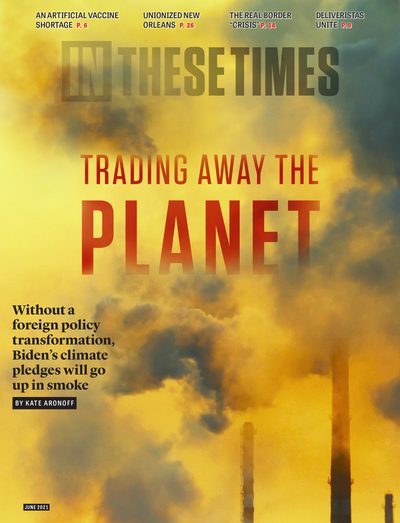The Perils of an “America First” Climate Policy
To meet his climate promises, Biden will have to abandon the U.S. tradition of hawkish nationalism in favor of global cooperation.
Kate Aronoff
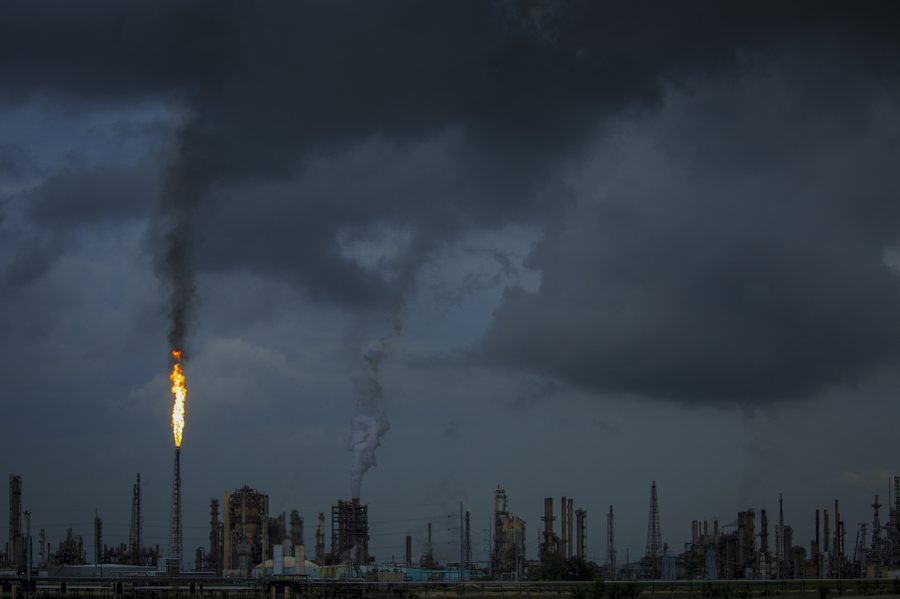
This Earth Day, April 22, President Biden presided over a flashy White House Climate Summit aimed at restoring U.S. leadership in the fight for the planet. He pledged to pay $5.7 billion per year for global adaptation and mitigation and to reduce U.S. greenhouse gas emissions by 50%- 52% below 2005 levels within the next decade. However, Biden’s pledges fall far short of the $800 billion down payment and 195% in cuts that climate justice groups calculate to be the United States’ fair share. And the United States still has no laws in place to enforce even the dangerously modest goals it has set for itself.
Other countries could be skeptical of trusting its word, given that the U.S. left the Kyoto Protocol and left (then rejoined) the Paris Agreement.
Plus, “America First” still rules the day, with the Biden administration positioning climate action as an opportunity for U.S. companies to dominate export markets and hoard green intellectual property. As Biden told a joint session of Congress in April, “We’re in competition with China and other countries to win the 21st century.”
Still, movements for the Green New Deal have managed to push the domestic climate conversation, and legislation to reduce emissions looks more possible than it has in at least the past decade. The White House has pledged up to $1 trillion in clean energy investments over the next 10 years, along with meaningful commitments to job creation and environmental justice. And a U.S. president is finally centering their platform on climate change, even if Biden’s promises and lofty rhetoric are mostly just that, in keeping with decades of Democratic Party climate politics.
But who wins when an existential threat is cast as a new Cold War? The planet doesn’t much care whether emissions rise over Detroit or Shenzhen, or who gets rich mitigating climate change. Decarbonizing as fast as possible requires priorities beyond hawkish nationalism and corporate profit.
In keeping with decades of Democratic Party climate politics, Biden has yet to acknowledge the massive climate debt the U.S. owes the world. Nor has he done much to directly curb Big Oil, which continues to put itself at the center of the global climate policymaking debate.
Real U.S. climate leadership would mean doing something this country has never been great at: transforming itself for the better, without some foreign threat (real or imagined). Like his predecessors, Biden has yet to leverage the most powerful tools he has to stem carbon and capital: our outsize sway over the trade rules and international institutions that, unlike climate pledges, have real teeth.
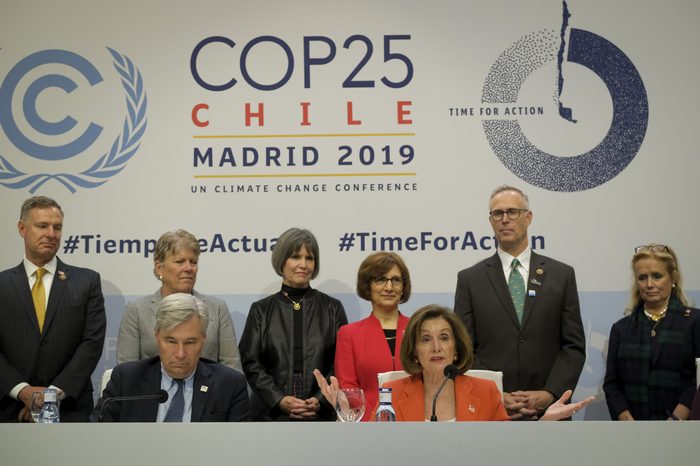
Standing before a press conference during the first week of talks at the United Nations Climate Change Conference (known as COP25) in Madrid in December 2019, U.S. House Speaker Nancy Pelosi — flanked by members of the House Select Committee on the Climate Crisis — echoed the talking points of Michael Bloomberg, Jerry Brown and others who had gathered at similar events previously: “The United States is still in.”
“Combating the climate crisis is the existential threat of our time,” Pelosi said, “and it was essential that our delegation stand with international partners, who are continuing to build upon and solidify their commitments to meet the Paris Agreement’s goals.”
Pelosi’s trip was short; there was real business to attend to back in Washington. That week, she hustled to pass the U.S.-Mexico-Canada Agreement, or USMCA — otherwise known as NAFTA 2.0.
Trump first signed this pet trade deal in 2018, but House Democrats pushed back, calling the proposal “f lawed and dangerous.” Pelosi and other moderate Democrats now saw a deal as necessary for proving to conservative voters that they could “do something” before heading into the 2020 campaign cycle. Their strategy was bipartisanship by any means necessary. The result would have a bigger impact on the climate than any statement Pelosi and company made at COP25.
While the text of the USMCA doesn’t mention the climate crisis, it does plenty to fuel it. Like just about every trade agreement on Earth, USMCA has more enforcement power than the Paris Agreement. Yet it includes no binding limits or enforcement mechanisms for pollution. It encourages fossil fuel exports. Companies can still dodge climate, labor and environmental regulations at the state and city level in the United States in favor of more lenient laws elsewhere. And a novel measure lets companies challenge new regulations before they’re even finalized, mounting new hurdles to future climate laws.
The USMCA was a deal Democrats, Pelosi said, should “take great pride … in advancing.” It was also an unmitigated win for Trump, who — along with the world’s biggest polluters — got most everything he wanted out of the USMCA.
“For the natural gas and oil industry, USMCA means more jobs, stronger energy security and continued economic growth,” boasted American Petroleum Institute President and CEO Mike Sommers.
The apparent disconnect between Pelosi’s enthusiasm for both the Paris Agreement and the USMCA may or may not be intentional. In any case, it’s not unique. It’s also climate denial.
For most establishment Democratic politicians, climate change is simply an issue to have a good line on: We Are Still In. We Believe Science. We Will Rejoin the Paris Agreement. The climate, as a singular issue, is thought to float in the clouds above supposedly meatier and more pressing issues like jobs and trade and the economy, something to be rolled out when it’s a political winner and stowed away when it’s not. That fails to account for the urgency of the crisis.
Acknowledged or not, countries and corporations alike are all fighting for their share of our remaining carbon budget—the amount of pollution that can be expended before the world crosses over a threshold of warming with catastrophic effects. The biggest consumers of fossil fuels can leave space in the carbon budget for other places to develop prosperous and ultimately low-carbon economies that are resilient against the kind of climate-fueled storms, floods and droughts already headed their way. Or they can keep eating up that remaining carbon budget as they’ve been doing, without a second thought that others might want a slice of the pie.
The United States has tended to prefer the latter option. It was Republican President George H.W. Bush who famously said the “American way of life is not up for negotiation” at the Rio Earth Summit in 1992, where the United Nations Framework Convention on Climate Change (UNFCCC) was adopted (under which today’s Paris Agreement is nested).
But it was President Barack Obama’s lead climate negotiator, Todd Stern, who echoed a similar sentiment nearly two decades later in South Africa: “If equity’s in, we’re out.”
The Third World Network has been involved in the UN climate process since UN climate talks began in the 1990s, consulting with countries in the Global South to push for greater equity and ambition. Its legal adviser and senior researcher, Meena Raman, a veteran of these summits, possesses what can only be described as an encyclopedic knowledge of the UNFCCC process. She’s quick to emphasize that bad behavior by the United States at UN climate talks didn’t start with Trump. Without a dramatic overhaul in U.S. foreign policy, it won’t end with him, either.
“The problem is the crime that Donald Trump is committing — to deny climate science now … you can’t,” Raman said. “Nobody should deny that. People are dying. That’s really criminal. But the U.S. has never been a leader. It’s always taken everybody backward.”
Documents leaked by whistleblower Edward Snowden showed the Central Intelligence Agency enlisted the National Security Agency to surveil private communications among delegations at the 2009 UN climate talks in Copenhagen. Just before those talks, the United States and other developed countries were widely suspected of influencing the Philippines’ decision to pull veteran negotiator Bernarditas de Castro Muller, one of the most notoriously fierce advocates for developing countries, from its team. The U.S. negotiators, like others from developed countries, regularly dangle billions of dollars of aid to developing countries to extract support for their climate positions. In 2010, the United States ended up cutting aid to Ecuador and Bolivia because they opposed the Copenhagen accord.
As ever, the line between what constitutes an official U.S. governmental priority versus that of its biggest companies is thin. Only state actors can officially negotiate over the text of climate agreements, including the Paris Agreement, but corporations can be “observers” to that process, just as NGOs and trade unions can. The World Health Organization, by contrast, has a stringent conflict of interest policy. Its Framework Convention on Tobacco Control bars the tobacco industry from entrance into negotiations, for example, citing the need to protect those talks against the “vested interest of the tobacco industry.” The UNFCCC has never adopted a parallel conflict of interest policy.
As calls for fairness and ambition from climate-vulnerable countries have been shut down, the world’s biggest polluters have had no trouble being heard. An analysis by the Climate Investigations Center found that, between 1995 and 2018, the International Emissions Trading Association (a trade lobby representing polluters at climate talks) sent 1,817 delegates to the UN. The International Petroleum Industry Environmental Conservation Association sent just 258. Industry groups regularly send delegations larger than those of many sovereign nations; their return on investment has been stellar.
Tucked away at the International Emissions Trading Association Business Hub at COP24 in 2018, in Katowice, Poland, Shell climate change adviser David Hone bragged about just how strong a hand his company had played in making sure carbon markets were central to the Paris Agreement. “We have had a process running for four years for the need of carbon unit trading to be part of the Paris agreement. We can take some credit for the fact that Article 6 [of the Paris Agreement] is even there at all,” Hone boasted.
“We put together a straw proposal. Many of the elements of that straw proposal appear in the Paris Agreement. We put together another straw proposal for the rulebook, and we saw some of that appear in the text.”
In a perfect world for fossil fuel producers, Hone told me after the session, those carbon unit trading mechanisms would be the only government mitigation policies on the table, echoing Exxon’s priorities on carbon pricing. “The ideal for a cap-and-trade system is to have no overlapping policies … if you really wanted it to work as effectively as it possibly could,” Hone said. “But I’m being a bit idealistic there, I suspect.”
Shell — which ranks seventh in companies with the largest carbon dioxide emissions worldwide since 1965 —isn’t nearly as beloved outside the International Emissions Trading Association pavilion. Philip Jakpor, head of media and campaigns for Environmental Rights Action in the Niger River delta, has seen the effects of Shell’s oil and gas business firsthand. Shell operates some 200 gas flares in the Niger Delta region that burn for 24 hours a day, despite having been repeatedly declared illegal there.
Nearby communities, Jakpor said, deal with rashes, respiratory problems and disruptions to farms and fishing as a result. They have been fighting against Shell to stop the practice for years. “Shell is gassing these communities out of existence,” Jakpor told me. Rather than ending the practice and complying with national law, oil companies have sold carbon offset credits for new infrastructure to prevent flaring.
“The community is not saying make money from this. The community is saying stop the gas flaring,” Jakpor added. “We have said time and again that the solution[s] are nonmarket mechanisms. We are against the commodification of the environment. If we allow this, even the air we breathe will be commodified. The way to go is to end fossil fuel extraction. And we don’t want companies like Shell and their cronies crawling all over the place trying to influence the talks.”
For now at the UNFCCC, those who benefit from Shell’s upstream profits have a greater say over how the world responds to the climate crisis than the people forced to deal with the consequences of its business model downstream.
“A proposal for curbing emissions from the developed world so that the billion individuals who live without electricity can enjoy its benefits would probably pass in a landslide in a world referendum,” activist and filmmaker Astra Taylor writes of climate change’s democratic conundrum, “but it would likely fail if the vote were limited to people in the wealthiest countries.” For the most part, and by design, it has been.
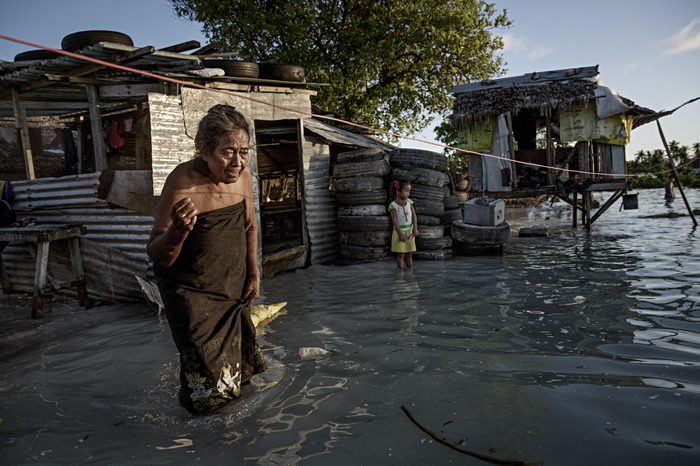
A 2019 report from the UN Environment Program noted the gap between countries’ planned commitments under the Paris Agreement (known as nationally determined contributions, or NDCs) and what it will actually take to meet the Paris Agreement’s lofty goals.
If existing NDCs are actually met, then temperatures will shoot up by 3.2 degrees Celsius, leaving major coastal cities and some whole nations underwater, with collapsing crop yields worldwide. To get back on track for only a 1.5 degree Celsius rise in global average temperatures, per demands from the Global South, global emissions need to decline 7.6% each year between 2020 and 2030. That’s far greater than the largest single emissions drop in world history, the collapse of the Soviet Union. Every year. For a decade.
“Common but differentiated” — language from the UNFCCC — has generally been interpreted to mean the burden of carbon reduction should be shared equitably. Sivan Kartha, a former lead coordinating author of the Fifth Assessment Report for the UN Intergovernmental Panel on Climate Change, researches how to make that happen.
Between 1850 and 2002, the Global North emitted three times as much greenhouse gas as the Global South, where some 85% of the world’s population lives. By 2030, experts estimate loss and damage costs alone in developing countries could easily reach $300 billion annually. The Civil Society Equity Review finds that the combined historical greenhouse gas emissions of the United States and the EU should make them responsible for 54% of that. Among climate justice advocates, this responsibility goes by the name “climate debt.”
The United States and countries like it, Kartha explains, now have the greatest capacity to do two things within the UNFCCC: rapidly decarbonize their economies with ambitious NDCs and provide financing that allows less-developed countries to do the same. But there’s still no means through which to distribute loss and damage financing, despite years of pressure. For their part, U.S. negotiators have consistently tried to keep discussions of loss and damage off the table entirely.
Equity in decarbonization, Kartha notes, is as much a moral commitment as a pragmatic one. Centuries of the Global North extracting wealth from the South — whether through colonialism or one of its many antecedents— means there’s vital trust to be rebuilt to make any kind of functional international agreement really work. On top of that are real material constraints: many places simply can’t afford to build thriving, low-carbon societies, particularly as they try to deal with the climate-induced disasters that are disproportionately clobbering them.
Wealthy countries built their massive economies off land, labor and resources extracted from what is today the Global South. Now they’ve got more than enough resources to make a transition possible for the places that furnished that wealth.
After centuries of plunder, both bank accounts and trust need to be rebuilt if a global transition is going to happen as fast as we need it to. “Ambition needs to improve mitigation, adaptation and means of implementation,” Palestinian ambassador Ammar Hijazi, lead negotiator for the UN Group of 77 (developing countries) plus China, said in Madrid. “If you ask me to climb a mountain and I don’t have the muscles to do that, you are asking the impossible.
“An electric car is still an expensive commodity. I buy an electric car in Palestine; there are only four or five charging stations. Then I’m stuck with this car that doesn’t take me anywhere.”
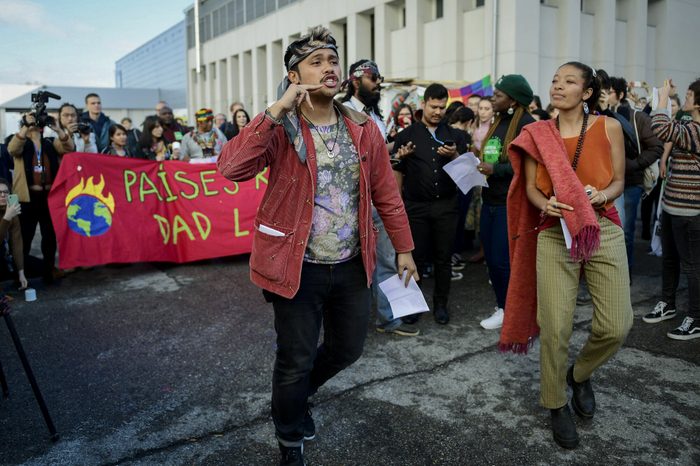

From an energy tax to the Copenhagen Summit to cap-and-trade to the Paris Agreement, the script in the United States is the same: One arm of industry spends hundreds of millions battering the idea that anything should be done about climate change, speaking most effectively through the Republican Party. Another steps in with a seemingly reasonable alternative that is lauded by Democrats. Republicans and their allies in the fossil fuel industry hit that with everything they have, and the cycle begins again, with those at least nominally interested in passing something called climate policy bringing weaker proposals they think will be more amenable to an opposition whose main goal is not passing anything, triangulating themselves and the planet toward oblivion.
It’s a race to the bottom, leaving out not only what most of the public in the United States actually wants but basic material realities about what is required to deal with the crisis, the worst impacts of which will be felt beyond U.S. borders. For most politicians, it’s been easier to neglect climate politics altogether. To have any kind of fighting chance of meeting the Paris Agreement goals — living up to what most Democratic politicians say they want — the realm of what should be considered climate policy has to expand radically, starting with an honest accounting of where emissions are coming from.
“Given that emission transfers via international trade are a significant and growing share of country, regional and global emissions,” climate modeler Glen Peters and several of his colleagues wrote back in 2011, “we suggest that policies that affect international trade should not be continually separated from climate policy.”
National emissions inventories considered by the UNFCCC and the UN Intergovernmental Panel on Climate Change, however, still only track the emissions a country produces within its own borders, known as “territorial emissions.” This number leaves out a whole range of activities, like the carbon emitted elsewhere to produce imports, or the carbon costs of companies headquartered in the Unit ed States with operations abroad; in other words, trade. When U.S. politicians talk about their ambitions to reach net-zero emissions by 2050, for instance, that doesn’t tend to include the millions of barrels of oil and gas the United States exports to be burned abroad each day.
Overshoot on these goals is funneled into a black box of “offsets,” an umbrella category for things that suck up carbon. Frequently, these include land grabs for forests halfway around the world. Faulty accounting in these loosely regulated offset projects can end up swelling, not subtracting, from emissions. And as globalization has encouraged U.S. companies to move their factories elsewhere, their emissions have traveled too, out of sight and mind for politicians and corporations eager to put on a green face. Because of idiosyncrasies in how carbon is counted, the United States has come out looking better than it should.
The seemingly miraculous trend of primarily Global North countries’ “absolute decoupling” of GDP growth from emissions tends to obscure the carbon-intensive manufacturing that gets shifted abroad. For example, though U.S. territorial emissions increased by 9% from 1990 to 2014, consumption-based emissions — those accounting for trade — increased by 17% over the same period. While recent evidence suggests absolute decoupling is actually possible, it is not happening nearly fast enough (or in enough places) to make the case that booming, endless growth is a steady route to decarbonization.
If technocratic fixes around the edges of the growth engine might have seemed to ward off catastrophe a decade or two ago, they certainly won’t now.
As each fresh disaster is making clear, the only safe path forward through the 21st century and beyond runs through a reimagining of what society values most and to whom it listens. There was nothing inevitable about how the system we now live in was built, and plenty of calls for genuine democratic alternatives were stamped out along the way. History doesn’t offer a blueprint, in that respect. But it can provide some solace that the powers that be have had to work diligently throughout the past several decades to maintain business as usual. That control is finally starting to crack.
Excerpted from Overheated: How Capitalism Broke the Planet — And How We Fight Back by Kate Aronoff. Copyright © 2021. Available from Bold Type Books, an imprint of Hachette Book Group, Inc.
Kate Aronoff is a staff writer at The New Republic and author of Overheated: How Capitalism Broke the Planet — And How We Fight Back. She is co-author of A Planet To Win: Why We Need a Green New Deal and co-editor of We Own the Future: Democratic Socialism—American Style. Follow her on Twitter @katearonoff.
